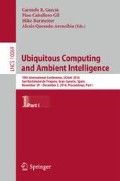Abstract
Clinical gait analysis provides an evaluation tool that allows clinicians to characterize person’s locomotion at a particular time. There are currently specialized systems to detect gait events and compute spatio-temporal parameters of human gait, which are accurate and redundant. These systems are expensive and are limited to controlled settings with gait evaluations widely spaced in terms of time. As alternative, a proposal for long-term gait monitoring in Assisted Living Environments based on an infrastructure of wireless inertial sensors is presented. Specifically, heel-strike events will be identified in multiple elders in a rest home and throughout the day. A small wearable device composed of a single inertial measurement unit will be placed at the back of each elder, on the thoracic zone, capturing trunk accelerations and orientations which will enable the demarcation of heel-strike events and the computation of temporal gait parameters. This proposal attempts to contribute to the development of a less intrusive and reachable alternative for long-term gait monitoring of multiple residents, which has been poorly investigated.
Access this chapter
Tax calculation will be finalised at checkout
Purchases are for personal use only
Notes
- 1.
Inter-Integrated Circuit data serial bus.
- 2.
6-Degrees of Freedom IMU (3-axis accelerometer and 3-axis gyroscope).
- 3.
MQTT (Message Queuing Telemetry Transport). It is a lightweight transport protocol based on publication/subscription policies to defined messages, known as topics.
- 4.
Gait parameter estimation in clinical settings generally uses straight paths because turns or changes in the gait trajectory distort the measurements.
References
Brach, J.S., Perera, S., Studenski, S., Newman, A.B.: The reliability and validity of measures of gait variability in community-dwelling older adults. Arch. Phys. Med. Rehabil. 89(12), 2293–2296 (2008)
Hausdorff, J.M.: Gait variability: methods, modeling and meaning. J. NeuroEng. Rehabil. 2, 19 (2005)
Fontecha, J., Navarro, F.J., Hervas, R., Bravo, J.: Elderly frailty detection by using accelerometer-enabled smartphones and clinical information records. J. Pers. Ubiquit. Comput. 17(6), 1073–1083 (2013)
Camicioli, R., Howieson, D., Oken, G., Sexton, G., Kaye, J.: Motor slowing precedes cognitive impairment in the oldest old. Neurology 50(5), 1496–1498 (1998)
Moore, S.T., MacDougall, H.G., Gracies, J.M., Cohen, H.S., Ondo, W.G.: Long-term monitoring of gait in Parkinson’s disease. Gait Posture 26(2), 200–207 (2007)
Verghese, J., Lipton, R.B., Hall, C.B.: Abnormality of gait as a predictor of non-Alzheimers dementia. N. Engl J. Med. 347(22), 1761–1768 (2002)
Hausdorff, J.M.: Gait dynamics, fractals and falls: finding meaning in the stride-to-stride fluctuations of human walking. Hum. Mov. Sci. 26, 555–589 (2007)
Grimpampi, E., Bonnet, B., Taviani, A., Mazzà, C.: Estimate of lower trunk angles in pathological gait using gyroscope data. Gait Posture 38, 523–527 (2013)
Novak, D., Goršič, M., Podobnik, J., Munih, M.: Toward real-time automated detection of turns during gait using wearable inertial measurement units. Sensors 10, 18800–18822 (2014)
Zijlstra, W., Hof, A.: Assessment of spatio-temporal gait parameters from trunk accelerations during human walking. Gait Posture 18(2), 1–10 (2003)
Hartmann, A., Luzi, S., Murer, K., De Bie, R.A., De Bruin, E.D.: Concurrent validity of a trunk tri-axial accelerometer system for gait analysis in older adults. Gait Posture 29(3), 444–448 (2009)
Mansfield, A., Lyons, G.M.: The use of accelerometry to detect heel contact events for use as a sensor in FES assisted walking. Med. Eng. Phys. 25(10), 879–885 (2003)
González, I., Fontecha, J., Hervás, R., Bravo, J.: Estimation of temporal gait events from a single accelerometer through scale-space filtering. J. Med. Syst. (accepted) (published in 2016)
González, I., Fontecha, J., Hervás, R., Bravo, J.: An ambulatory system for gait monitoring based on wireless sensorized insoles. Sensors 15(7), 16589–16613 (2015)
Acknowledgements
This work is supported by the FRASE MINECO project (TIN2013-47152-C3-1-R) and the Plan Propio de Investigación from Castilla-La Mancha University.
Author information
Authors and Affiliations
Corresponding author
Editor information
Editors and Affiliations
Rights and permissions
Copyright information
© 2016 Springer International Publishing AG
About this paper
Cite this paper
González, I., Fontecha, J., Hervás, R., Naranjo, M., Bravo, J. (2016). A Proposal for Long-Term Gait Monitoring in Assisted Living Environments Based on an Inertial Sensor Infrastructure. In: García, C., Caballero-Gil, P., Burmester, M., Quesada-Arencibia, A. (eds) Ubiquitous Computing and Ambient Intelligence. UCAmI 2016. Lecture Notes in Computer Science(), vol 10069. Springer, Cham. https://doi.org/10.1007/978-3-319-48746-5_31
Download citation
DOI: https://doi.org/10.1007/978-3-319-48746-5_31
Published:
Publisher Name: Springer, Cham
Print ISBN: 978-3-319-48745-8
Online ISBN: 978-3-319-48746-5
eBook Packages: Computer ScienceComputer Science (R0)

